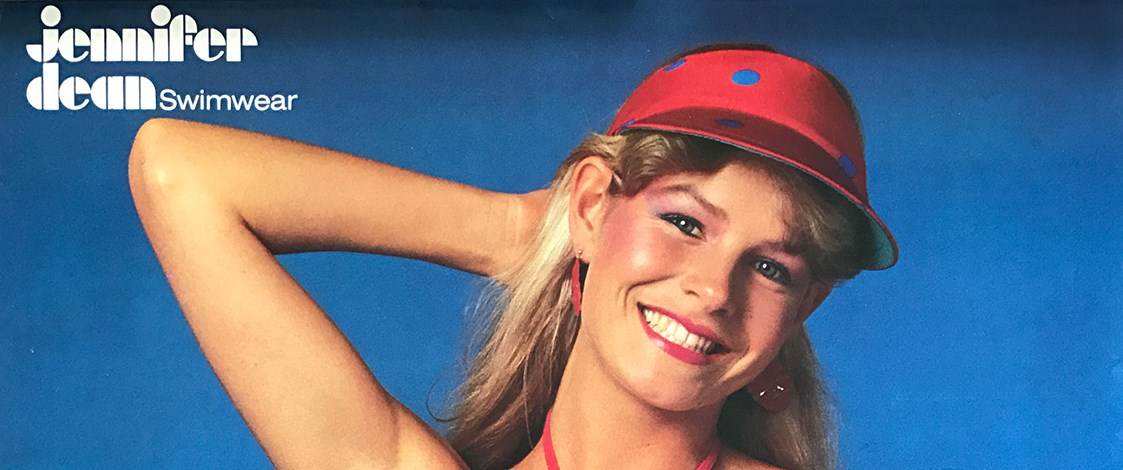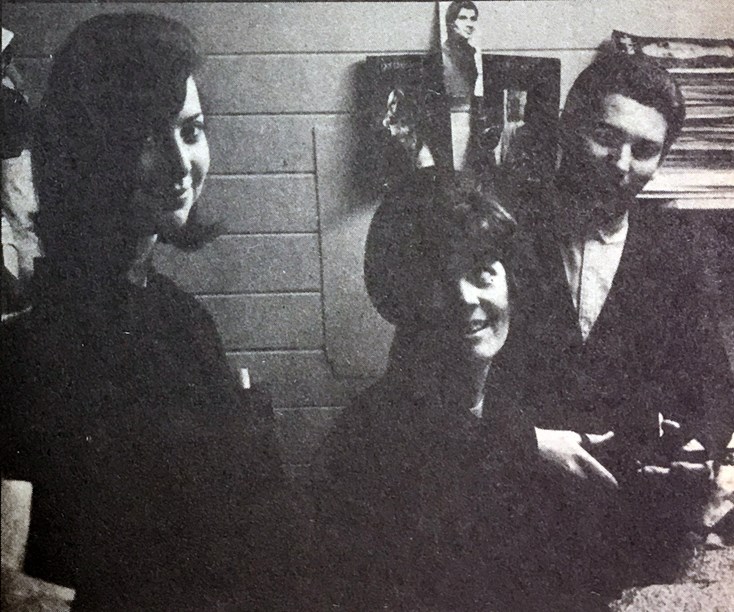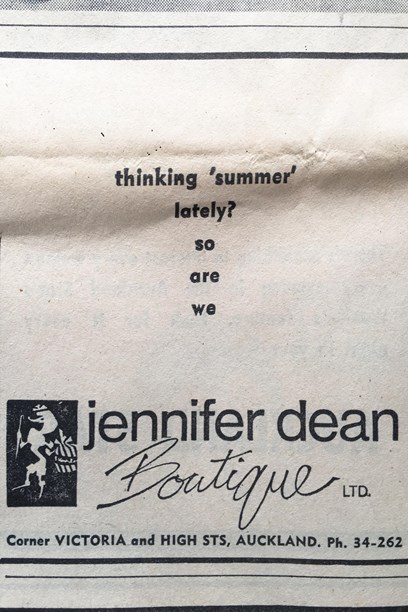Stories
Jennifer Dean
1960-

Jennifer Godward established her label in 1960 at her kitchen table while her first born son Dean, played happily underneath. "I started to make cot sheets, cute little cotton ones edged with broderie anglaise. There weren’t any on the market and we knew an agent who could sell them. That was really the beginning of the Jennifer Dean label," she recalls.
Sewing had long been a passion for this self-taught seamstress who remembers the excitement of rushing home from work with a Butterick’s pattern and a new piece of fabric.
Jennifer also remembers how unexcited she was about her job as a shorthand typist. And how glad she was at being offered work at Lois Taylor’s Gianni Boutique, the very place that she and her then husband Barry would go on to establish as the Jennifer Dean Boutique in 1961.

Jennifer Godward (centre) with husband Barry and cutter Sally Syder, 1966. Image from Playdate magazine. Photo © unknown.
It was a small room on the first floor at 10 Vulcan Lane, sandwiched between the ground floor Coffee Bean café and the third floor The Loft – at that time Auckland’s go to music store owned by Jim Foley. The Loft had a great following of musicians, artists and Jennifer recalls working to the strains of Barry McGuire’s 'Eve of Destruction' coming down from above while aromas from the Coffee Bean drifted upwards. "It was a perfect mix of people, we really complemented each other," she recalls. "We were young, fearless and on the wave of the fashion revolution that was happening in the sixties and seventies." Although untrained as a designer, she set about creating innovative clothing for the young, fashionable woman of her era. "In those days each season would bring a new fashion trend, for example, the mini, the bell- bottom trouser, the peasant look or the maxi. Our customers wanted the latest styles and colours and my challenge was to interpret the trends of the time, add a twist and make it into the Jennifer Dean look."
Jennifer has memories of herself dressed in long paisley skirts, smock tops and beads, or bell-bottoms worn with skyscraper platform soles. "My favourite look of that era was a very short leather mini with the compulsory opaque white tights and a pair of Mary Janes on my feet. Later I fell in love with the more streamlined look of Courreges and his angular mini dresses and this was reflected in the designs I produced for Jennifer Dean."
When bikinis were introduced to her range, something few other designers were doing at the time, they flew off the shelves as fast as she and her small staff could make them. Crowds would queue on Friday nights to buy her latest itsy-bitsy floral, gingham, and even macramé swimwear creations. "Brigitte Bardot was a style icon of that era and she was known for wearing gingham. We took this idea and made gingham bikinis and playsuits trimmed with white lace and we couldn’t make enough."
In 1964 the launch of her so-called 'topless bikini' at The Loft generated huge publicity but no actual sale of the said item. "The place was packed with men and the press. You couldn’t move. The swimsuit was in fact not topless as the model had two straps leading from the bikini bottom over her boobs. It was incredibly risqué for the time."
The label soon became so successful that larger premises on the corner of Victoria and High Street were secured in 1966. "Next door was a menswear store called Raymond’s owned by Ray and Billy Barker which would later be known as 'Barkers'. The two stores worked brilliantly together and we had a lot of fun."

Newspaper advertisement for Jennifer Dean Boutique, 1967.
By 1970 over a third of the Jennifer Dean retail space was devoted to swimwear made in their Chancery Street factory and wholesaled nationwide.
Reflecting on her fashion philosophy Jennifer says the most important things she learned were to: "Listen to your customer, stay away from gimmicks, use only quality fabrics and employ experienced machinists."
Surviving the 1980s deregulation of the economy and the 'crash' years was difficult, but with smart marketing that included supermodels such as Lorraine Downes and Rachel Hunter, the Jennifer Dean brand thrived. The arrival of spandex as a fabric was also a game changer in the swimwear industry.

Rachel Hunter for Jennifer Dean. Image © Jennifer Dean.
The Jennifer Dean label was sold to Don and Cathy Cederwall in 1990. By that time it was solely associated with swim and beachwear.
On a personal level things had changed too. Now a solo parent, Jennifer developed a new label 'Jenny G' with the help of a small business loan and three machinists. They worked out of the basement of her small Remuera house selling from there and also supplying a few stores. Remarriage brought further changes. Jennifer (now Coles) began university studies, something she had long wanted to do.
But the fashion business was always a lure and in 2003 she became the owner of Ponsonby boutique, Adorno. Over the years she has developed the stock, buying for a diverse range of clients from collections in Paris, London, New York and Sydney. Adorno offers a selection of women’s clothing and accessories from international labels including Isabel Marant, Vanessa Bruni, The Row, Phillip Lim and Margaret Howell, and has an online store. "There is no age nowadays that a woman isn’t going to be interested in fashion," says this still glamorous fashion veteran. "And no," she laughs, "there are no bikinis in stock!"
The longevity of the Jennifer Dean label is almost unparalleled for a local swimwear brand. In 1990 Cathy Cederwall and her husband Don bought the brand to complement their purchase of the Barbera Leotard Company.

Cathy Cederwall with a rack of Jennifer Dean swimwear. Image © Cathy Cederwall.
The Cederwalls had no previous experience in the clothing business, although Cathy’s father was a draper and she loved fabrics. She can recall the anticipation she felt when shipments of Italian fabric arrived at their Mt Roskill factory, where at its peak, they employed around 30 machinists. During the 1990s they were wholesaling to department stores such as Smith & Caughey's in Auckland and Kirkcaldie & Stains in Wellington, and to retailers throughout both islands.
In 1999, after ensuring their machinists all had other jobs, the couple began manufacturing in China and importing other swimwear brands. In 2000 they moved to premises in Dominion Road which is still the Auckland headquarters of the Beach Hut, the chain of North Island stores they established to promote the Jennifer Dean label.
During the early 2000s they also established what Cathy describes as a "vibrant" export business to Australia, but when Don died in 2007 Cathy needed to make changes and the export side of the business was discontinued. These days son Tony heads the company, daughter Karen manages the Whangamata Beach Hut store, and Cathy still works in the Dominion Road store. All designs are done in New Zealand, members of the family travel internationally searching for new fabrics, ideas and styles and a few samples are still made up in the Dominion Road.
It it is the prestige of the Jennifer Dean brand that has been a hallmark of the Cederwalls’ business success to this day. "A lot of our clients remember Jennifer Dean from when they were teenagers," Cathy says. "We also have a long history of providing New Zealand women with quality swimwear. Women come back because they know our quality and fit can be depended on year after year."
Over the years a lot of swimsuit styles haven’t changed and some make a comeback. One thing that hasn’t changed at all is the New Zealand bikini bottom sizing. "We’re still using the same pattern for bottom sizes from the 1960s," Cathy laughs. Tops however are an entirely different story, she says, with sizes increasing remarkably over the years.
Cathy hopes the business will stay in the family and remain in New Zealand ownership for many years to come.
Text by Katherine Findlay. Banner image of Lorraine Downes modelling swimwear for a Jennifer Dean poster, 1980s. Image © Jennifer Dean.
Last published August 2017.